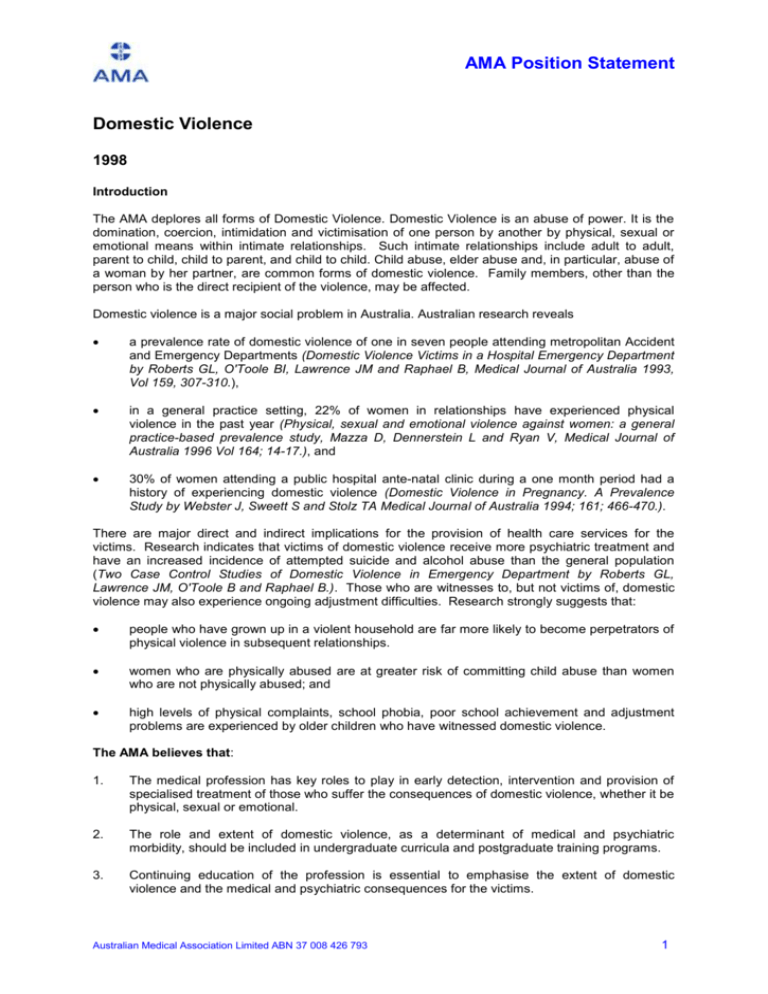
AMA Position Statement
Domestic Violence
1998
Introduction
The AMA deplores all forms of Domestic Violence. Domestic Violence is an abuse of power. It is the
domination, coercion, intimidation and victimisation of one person by another by physical, sexual or
emotional means within intimate relationships. Such intimate relationships include adult to adult,
parent to child, child to parent, and child to child. Child abuse, elder abuse and, in particular, abuse of
a woman by her partner, are common forms of domestic violence. Family members, other than the
person who is the direct recipient of the violence, may be affected.
Domestic violence is a major social problem in Australia. Australian research reveals
a prevalence rate of domestic violence of one in seven people attending metropolitan Accident
and Emergency Departments (Domestic Violence Victims in a Hospital Emergency Department
by Roberts GL, O'Toole BI, Lawrence JM and Raphael B, Medical Journal of Australia 1993,
Vol 159, 307-310.),
in a general practice setting, 22% of women in relationships have experienced physical
violence in the past year (Physical, sexual and emotional violence against women: a general
practice-based prevalence study, Mazza D, Dennerstein L and Ryan V, Medical Journal of
Australia 1996 Vol 164; 14-17.), and
30% of women attending a public hospital ante-natal clinic during a one month period had a
history of experiencing domestic violence (Domestic Violence in Pregnancy. A Prevalence
Study by Webster J, Sweett S and Stolz TA Medical Journal of Australia 1994; 161; 466-470.).
There are major direct and indirect implications for the provision of health care services for the
victims. Research indicates that victims of domestic violence receive more psychiatric treatment and
have an increased incidence of attempted suicide and alcohol abuse than the general population
(Two Case Control Studies of Domestic Violence in Emergency Department by Roberts GL,
Lawrence JM, O'Toole B and Raphael B.). Those who are witnesses to, but not victims of, domestic
violence may also experience ongoing adjustment difficulties. Research strongly suggests that:
people who have grown up in a violent household are far more likely to become perpetrators of
physical violence in subsequent relationships.
women who are physically abused are at greater risk of committing child abuse than women
who are not physically abused; and
high levels of physical complaints, school phobia, poor school achievement and adjustment
problems are experienced by older children who have witnessed domestic violence.
The AMA believes that:
1.
The medical profession has key roles to play in early detection, intervention and provision of
specialised treatment of those who suffer the consequences of domestic violence, whether it be
physical, sexual or emotional.
2.
The role and extent of domestic violence, as a determinant of medical and psychiatric
morbidity, should be included in undergraduate curricula and postgraduate training programs.
3.
Continuing education of the profession is essential to emphasise the extent of domestic
violence and the medical and psychiatric consequences for the victims.
Australian Medical Association Limited ABN 37 008 426 793
1
AMA Position Statement
4.
Continuing education of the profession is also necessary to highlight the critical role of primary
health care providers, especially general practitioners, emergency department personnel and
midwives, in the early detection of victims of domestic violence.
5.
Close collaboration and a coordinated approach with other community agencies is essential
when dealing with domestic violence and its consequences.
6.
There is a need for continuing research into the emotional and social aetiology of domestic
violence. Development and evaluation of intervention programs for both offenders and victims
should be significant components within that research. Strategies to prevent domestic violence
must incorporate recognition, understanding, and management of the underlying problems of
the perpetrator.
7.
Due attention should be paid to the child witnesses of domestic violence. Intervention may
reduce the development of adjustment difficulties, and may modify the risk of those children
subsequently becoming perpetrators of domestic violence.
8.
Doctors have a responsibility to participate in community-wide efforts to establish and
strengthen resources for victims and perpetrators, and to encourage preventive education
programs through schools, the media and community organisations.
9.
The AMA supports initiatives undertaken by Federal and State Governments which recognise
and address issues relating to domestic violence within the community.
Reproduction and distribution of AMA position statements is permitted provided the AMA is acknowledged and that the
position statement is faithfully reproduced noting the year at the top of the document.
Australian Medical Association Limited ABN 37 008 426 793
2










